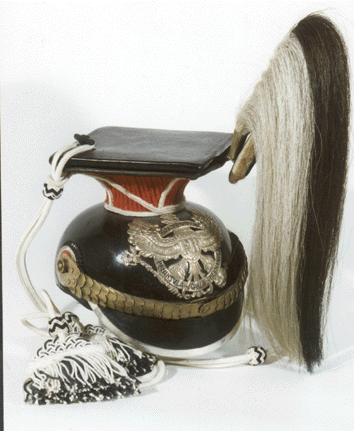the helmet of the month 01: Schapska of non-commissioned officer
of the 14th Prussian Uhlans Rgt. (2nd Hannoversches Ulanen-Rgt.)
![]()
the helmet of the month 01: Schapska
of non-commissioned officer
of the 14th Prussian Uhlans Rgt. (2nd Hannoversches Ulanen-Rgt.)

Since the creation of the Polish
lancers regiments by Napoléon, the Schapska became the traditional headdress
of lancers regiments of all countries.
Prussia, Austria and Russia have been created their Uhlans regiments with recruits
raised in their Polish districts absorbed after the sharing of Poland to the
XVIII century.
The Prussian schapska is made of rigid varnished leather. Its leather lining
is different as those of the spiked helmets. The model shown here comply with
the regulations of 1894/97: cornered mortaroard 14.5 cm wide, fixing of the
domed chinscales by lugs and loops (Knopfs 89), on the left only,e the empire
cockade (red white black).
The plate to the Prussian eagle of the Line carries the traditional scroll with
the motto "mit Gott Für Koenig und Vaterland" and the particular round
scroll described below. According to the regiment, fittings (and buttons of
the uniforms) were in white or yellow metal. In the Prussian regiments, chinscales
and fixing were always yellow (in brass or tombak).
The Feldzeichen (a wooden rosette covered with cloth) in the Prussian colours
(white and black) was placed on the middle of the left side of the mortarboard.
The Feldzeichen, as the Fangschnur (white cord with rackets and fringes - white
for the troop and mixed black and white for non-commissioned officers) was carried
in all circumstances.
On parade, a plume (Haarbusch) behind the Felzeichen and a Rabatte at the basis
of the mortarboard were added on the schapska. The Haarbusch was in white horsehair
for the troop (black and white for the Prussian non-commissioned officers) and
the ' Rabatte' made of cloth of the facing colour of the Rgt. (here crimson
red).
At their amalgamation in the Prussian army after the annexation of the Hannover
in 1866, the old Hannovrian Rgts were completely 'Prussianised', losing all
their distinctives. In 1899, Kaiser Wilhelm II awarded to all Hannovrian regiments
and those of the former Hesse-Nassau scrolls commemorating the engagement of
the troops of these states with the English army in Spain and at Waterloo.Thus
the 14th Uhlans Rgt. received on its headplate the battle honors " Peninsula
- Waterloo-Garzia-Hernandez " displayed on a round scroll.